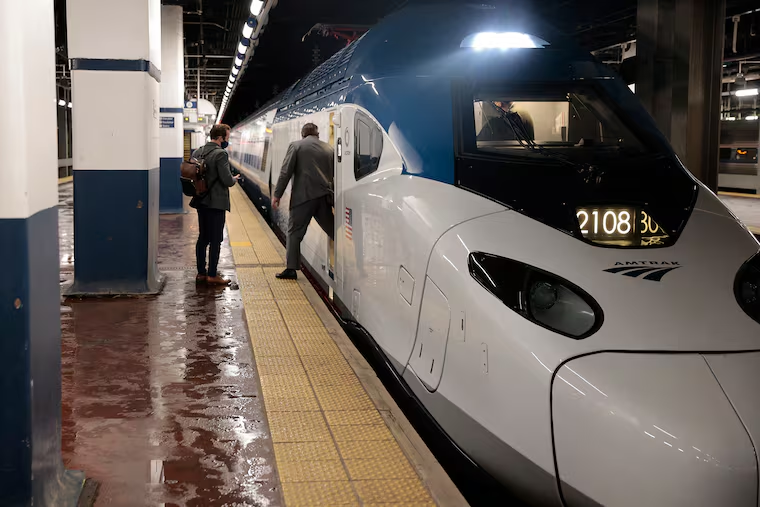New Acela trains are built for luxury and speed, but the Northeast Corridor needs a lot of work.
The new trains, along with track and signaling improvements, will boost speeds on the Northeast Corridor, though the U.S. is a long way from Japan-style high-speed rail.

Amtrak’s next generation Acela high-speed passenger train crouched next to the platform beneath 30th Street Station like some steel cheetah ready to go tearing down the tracks.
The nine-car beast is built to shave precious minutes on the Northeast Corridor between Washington and Boston: It’s articulated, with one set of wheels placed between cars so it doesn’t rock so much, and it’s 25% lighter than current Acelas.
And then there’s the outer loading door to the cafe car. No more holding up passenger boarding while crews are getting food and drink aboard.
“That may sound like a small change but it will all help us to turn trains faster and ultimately offer more service,” Laura Mason, Amtrak’s executive vice president for capital delivery, said Thursday.
But the trains, loaded with amenities, are not expected to improve travel times dramatically when they start entering service next fall because the railroad’s busiest route also needs massive upgrades to tracks, bridges, and tunnels to enable them to regularly reach their top rated speed of 160 mph.
That would cost nearly twice as much as the historic $66 billion that the federal infrastructure law allocates for the entire nation’s intercity rail service, according to a federal commission that has estimated the needs.
Today’s Acela trains can reach 150 miles per hour but only on some parts of the Northeast Corridor, due to infrastructure limitations.
Amtrak officials were busy showing off the train Thursday as the American Public Transportation Association was holding a conference in Center City on the future of high speed rail in the U.S., just as the federal government is pouring more than $1 trillion into infrastructure.
In 2016, the national passenger railroad agreed to buy 28 new train sets from Alstom SA for about $2 billion. They will replace 20 Acela trains that began service in 2000.
Acela is aimed at business travelers and drew 3.6 million passengers in 2019, compared to the 8.9 million riders on Amtrak’s regular Northeast Corridor coach service, which is slower and less expensive.
No. 2108 had that pleasing new train smell; some counters in the cafe car still had plastic covering on them. And the train features all the luxe passenger touches you might never have known you needed.
Along with bumping up the speed of Acela service to 160 mph, Amtrak wants the ride to be as friction-less as possible, in support of its long-time selling proposition that rail travel on the Northeast Corridor is more comfortable and convenient, and less stressful, than flying.
The new trains can carry 378 passengers, compared to 304 on the current model. No more pushing on the doors between cars; they open automatically. The aisles are wide enough to accommodate wheelchair users and the bathrooms are built to exceed requirements of the Americans with Disabilities Act, with enough room for a 5-foot turning radius, as well as touchless water faucets and soap dispensers and hand washers.
Headrests on the all first-class and business-class seats are self-contained “so you don’t fall asleep on your neighbor” as you nod off, Mason said.
Small knobs also protrude from the seats, so walking down the aisle won’t mean grabbing the seat cushion right next to somebody’s head, she said. “We heard loud and clear that was something people wanted.”
The train’s braking system recaptures electric energy and it has advanced technology that tilts its body on curves.
“It shifts the overall load center in the track so you can keep going faster, the same as when you’re driving through a banked turn in your car, you can maintain speed,” said Noah Heulitt, Alstom’s project manager for the new trains.
Traditional Northeast Regional coach-service trains can operate about 55 mph on curves, the new Acelas will be able to navigate them at 70 to 75 mph, Heulitt said.
Of the money going for rail in the infrastructure law, Amtrak is due to get about $22 billion, with $6 billion to be spent on improvements to the Northeast Corridor. Projects will also be eligible for $24 billion in competitive grants under the law.
The money will enable Amtrak to begin chipping away at the modernization plan put forward by the federal Northeast Corridor Commission, which envisions spending $117 billion by 2035 to remove choke points along the route, including new tunnels under the Hudson River.
Under the plan, Amtrak says it will be able to reduce the 2 1/2 hour trip from Washington to New York, and the 3 1/2 hour trip from there to Boston by 30 minutes each.